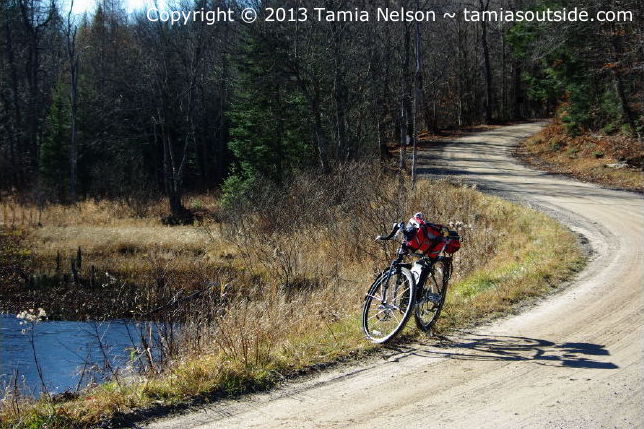The pleasures of cycling are so alluring that it’s easy to forget important things, so Tamia has drawn up rules to help guide her when she rolls out the driveway. They’re not for her alone, though. You’re welcome to use them too.
______________________________
by Tamia Nelson | July 12, 2013
It’s easy for me to get carried away when cycling—pushing on till I’ve ridden a bridge too far in the morning, say, and then regretting my exuberance as I slog the many weary miles home against a strengthening headwind. So, in order to temper my tendency to excess and insure I always finish a ride in at least as good shape as I started, I’ve developed a set of guidelines. They’re ten in all, and they mostly apply to riders who venture off the beaten track. Having yielded to the blandishments of egotism, I’ve unhesitatingly christened them “Tamia’s Ten Essentials, or, Rules of the Rural Road.” Adopt any or all of them for yourself. And here they are:
1. Don’t Sneak Off Without Telling Self reliance and independence are virtues, to be sure, but if you get into trouble it’s good to know Someone will come looking for you. So tell that Someone (1) where you’re going and (2) when you expect to be back. (And no, you can’t count on summoning help by cell phone. Not in many rural areas, anyway. A lot of rural cell networks are like fishnets: mostly holes.)
2. Bring Plenty of Water and Keep Your Bottles Topped Up Refill every chance you get, but don’t count on buying soda or water on the road. A lot of general stores are open only during the height of the touring season, and many houses in rural areas are occupied for just a few months of the year. A lot of rural America resembles a ghost town during the weekday. But thirst is still a dangerous thing. So carry enough water to get you out and back again. Better yet, if you ride in well-watered places, tuck a filter or UV purifier into your bar bag. Just in case.
3. Eat Often, But Not Too Much If you’ll be on the road for more than an hour, snack regularly. I eat a little something every 15 minutes or so. Every long ride is—or should be—a moveable feast. The alternative? Finishing the ride feeling totally washed out. Or not finishing at all. Can you spell “bonk”?
4. Slow and Steady Trumps Fast and Furious It’s fun to go fast. That is, it’s fun until a dog runs out from behind a hedge and under your front wheel, or a patch of gravel takes you down at the bottom of a long descent. Going over the bars at 20 mph or more can leave you unable to help yourself, and you can’t count on anyone dialing 911 for you. Rural folks aren’t necessarily good samaritans. In fact, if you’ve just hit their dog, they may well decide that the dog comes first. Or that you got what was coming to you. The upshot? You can lie unconscious in the road for a mighty long time. So slow down.
5. Take A Break—Often It doesn’t have to be long. In fact, it’s better if it isn’t. But it’s good to get off the bike for about five minutes every hour. Stretch your neck, touch your toes, take a drink, eat a bagel. Then get back in the saddle and head on down the road.
6. Know Your Limits Don’t think you can make the jump from your 10 mile commute to an 80 mile circuit in the mountains in one go. A ride that ends in a desperate slog isn’t much fun. And a tired rider is an accident waiting to happen. Fatigue slows your reflexes, impairs your judgment, and limits your ability to sprint out of danger. It can even make you see things that aren’t there—or worse yet, not see things that are. So don’t try to cover too much ground too soon. Build up to long distances.
7. Stay Cool If you ride on the road, you’ll regularly encounter drivers who endanger your life. Some are clueless incompetents. Others are psychopaths. And you usually can’t tell which are which. So keep your temper in check. Avoid confrontation. Shrug off taunts. A car—even a small car—is a world-class killing machine. To borrow the words of a famous naval gentleman, you’re too weak to fight and too slow to run away. Galling, I know. But true. Act accordingly.
8. Man’s Best Friend Is Your Worst Enemy Even a friendly dog who “just wants to play” can bring you crashing down in an instant. A large, aggressive beast can maim you for life—or worse. So stay alert. I don’t think anyone’s bothering to keep count, but I’d wager dogs injure more cyclists than the drivers of motor vehicles. Nobody enforces leash laws in rural America, so expect to encounter free-running dogs on most back roads. Halt II! is your best defense. Carry at least two cans.
9. Always Bring a Little Extra Bring plenty of extras. Extra water. Extra food. Extra tubes. Extra clothes. Extra batteries. Extra Halt!
10. Lend a Hand If you see a cyclist in difficulty, offer whatever assistance you can. Help a turtle across the road. Encourage a dilatory deer to get a move on before she’s struck by a speeding car. And—if you’ve got the stomach for it, along with a sturdy pair of gloves—remove the mortal remains of the ones who didn’t make it to the grassy verge, so that foraging predators aren’t lured onto the killing zone by the prospect of an easy meal. But beware: Don’t get so involved in what you’re doing that you end up under a car’s wheels yourself. There’s enough roadkill around already.
That’s it. Tamia’s Ten Essential Rules of the Rural Road. You can follow them, too.


